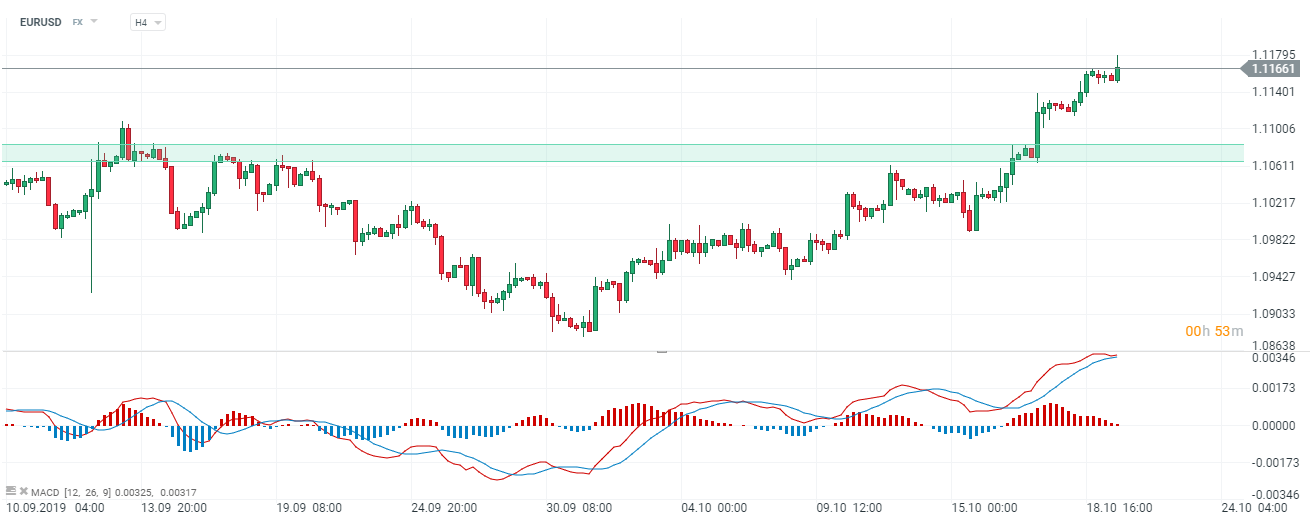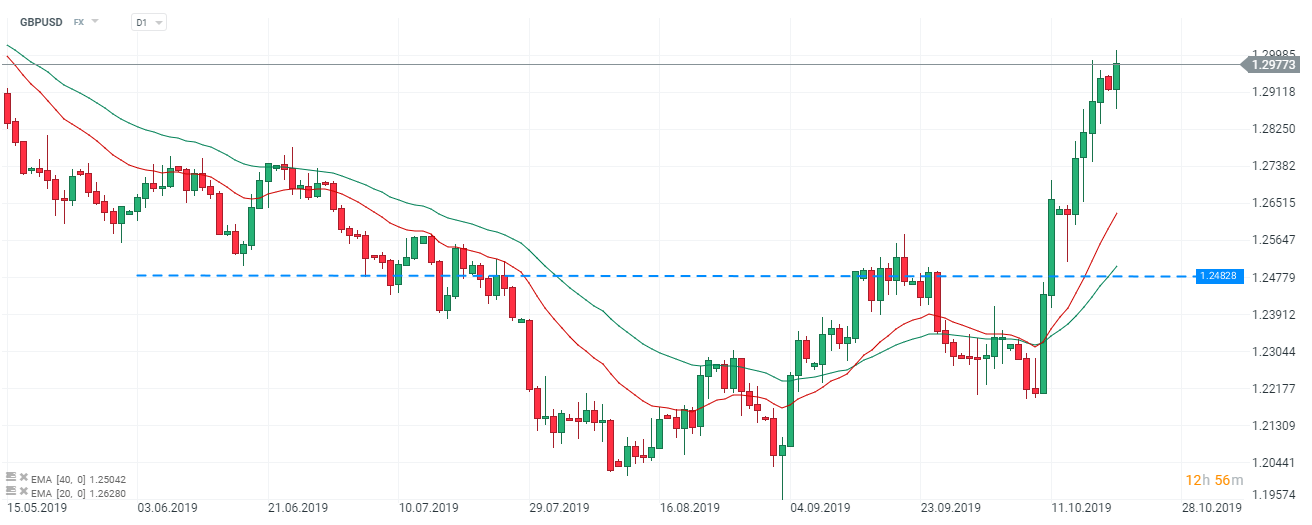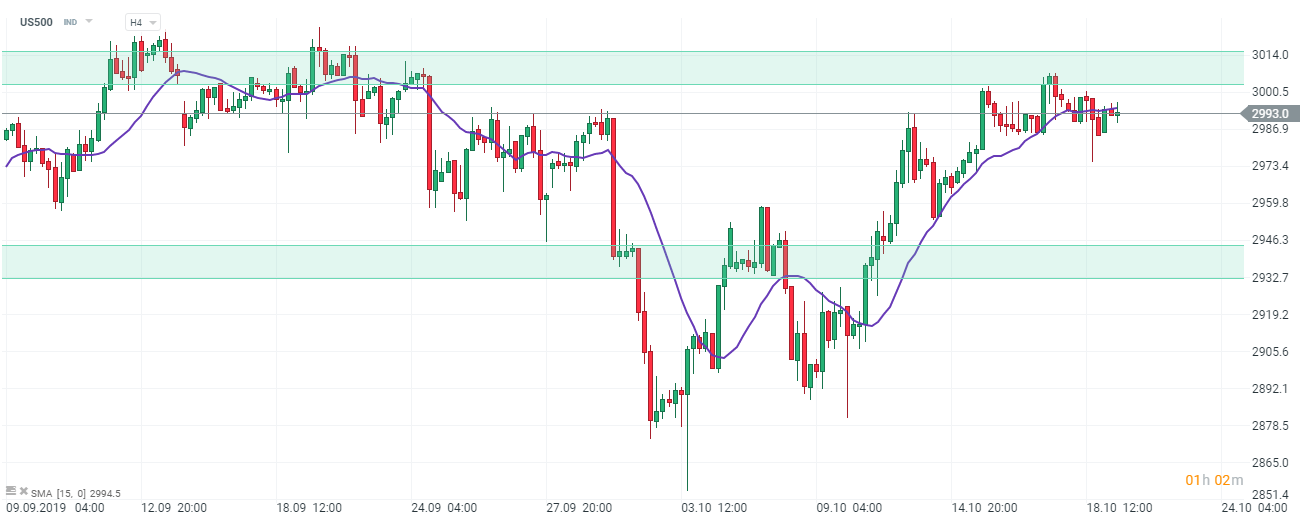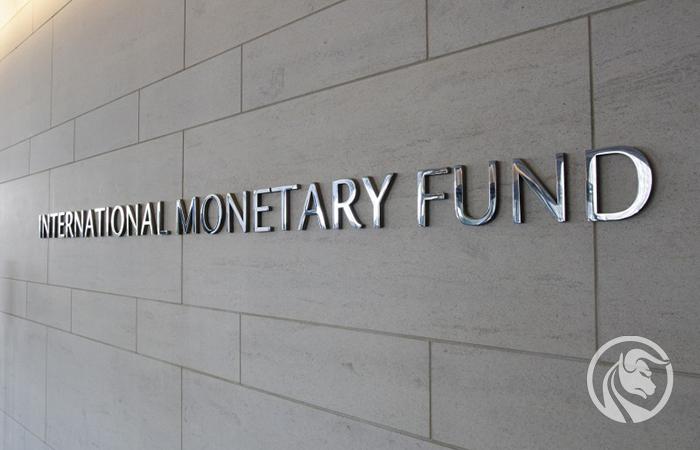Currency summary of the week - International Monetary Fund forecasts 3%
Last week, investors focused mainly on events in the UK regarding voting on Brexitu. Throughout the week, with special mention of Wednesday, important economic readings were flowing into the market. They concerned, among others, CPI inflation in the euro area, Great Britain and Canada. We also got to know September publications from the USA on base retail sales. Markets were reluctant to test this information themselves. The entire "show" of the past week has been stolen by conversations and agonizing about Brexit. In the background, however, the specter of the growing economic slowdown is still hanging over global trade.
More conversations
China has practically started the week since last Monday with a firm declaration to encourage the United States to engage more in talks. The initial agreement agreed is not sufficient, as can be seen. The increase in purchases (especially agricultural) made recently by the Chinese and refraining from implementing customs tariffs by the USA is not entirely satisfactory. These activities are treated by the Middle Kingdom as a foundation for a large trade settlement. The Chinese are interested in such a solution (even if it would delay the official signing of the agreement), which would postpone the introduction of customs duties announced by the US in December.

Chart EUR / USD, H4 interval. Source: xNUMX XTB xStation
Mixed sentiment put some anxiety on Monday's dollar quotes, and the US stock market cooled its post-weekend enthusiasm, which had an impact on the S & P500.
The announcement of talks alone brought enthusiastic, though strongly nervous, reactions during Asian sessions. Despite a lot of conflicting information, the Chinese deputy prime minister is still in the US, so it's hard to talk about the lower-level talk phase. The United States is more and more eagerly thinking about signing the Monetary Pact, which would mainly aim at embracing the issue of the devaluation of the yuan.
The Chinese economy is slowing down
China's problems with the economic slowdown. After the publication of the latest data for the third quarter, it is hard to expect a significant improvement by the end of the year. Readings released last Thursday, despite better results than expected and forecasted, did not affect the stock markets. The response was very weak. In annual terms, growth in the Middle Kingdom slowed by 6,0%. The decline in investment in the economy had a great impact on the mediocre result. This is the least optimistic on the side of the private sector of enterprises.
All readings indicate that the economic slowdown in China since 3 decades has not been at the same level as today. Despite decent data from industry and improved consumption, the main theme is still stagnation in the economy.
The slowdown in global growth is a component of many factors. This year, an additional burden is trade uncertainty and related restrictions and restrictions in world trade. The International Monetary Fund has recently released a forecast of global growth. Analysts do not expect a result higher than 3%. Considering all IMF publications, this is the worst forecast of global growth since the last economic crisis. The stagnation of international trade and the poor situation in the Chinese economy have a huge impact on stagnation.
Pound in the hands of parliament
Thursday Boris Johnson and the European Community came to an agreement on Brexit. Analysts agree that one cannot speak of one of the parties winning. Unfortunately, this is not the end of the turmoil regarding Britain's exit from the Union. The initial conclusion of the agreement will still bring us a lot of uncertainty because of the formal path that must go through the structures of the EU and Parliament.

Chart GBP / USD, D1 interval. Source: xNUMX XTB xStation
The agreement must be approved by all member countries. It can only hit the table in the British parliament and so adopted by majority. A minimum of two important meetings await him.
The agreement, as you can see, favors the pound. A strong upward trend has been maintained since October 11. In the event of any adverse reports on voting on the agreement, we can expect a deeper correction to around 1,27400.
The dollar is weakening
In addition to important data from China, the week abounded in US readings, mainly from the real estate market and industry publications. The former came out quite mixed, while American publications on industrial production came out much worse. Given the dynamics of change, there is a good chance that the negative trend will last a little longer.
Wall Street is currently in the middle of a season for publishing quarterly company reports, which may distract investors from weaker data from industry.
You can draw a meeting from the major events of last week FED on the purchase of short-term government debt securities T-bills. 60 billion USD is to be allocated for this purpose monthly. The Federal Reserve plans to continue the program until at least the second quarter of 2020 year. As the head of the Fed emphasizes, the purchase of T-bills is in no way associated with limiting quantitative easing in the US monetary policy.

US500 chart (CFD on the S&P 500), H4. Source: xNUMX XTB xStation
The program is to focus on increasing short-term reserves in the banking system. The acquisition of short-term securities is expected to lead only to changes in the short-term curve in a completely different area than QE. The program is expected to last 8 months, and therefore inventory reached 2 trillion dollars. This would be a level the market has not seen since 2018. Other repo and overnight operations will remain unchanged and are expected to last until January next year.
Currently, the S & P500 is at the key resistance from the last days at 3000 points. The pro-growth sentiment persisted in the last 2 weeks, therefore further comments from the Fed on the policy pursued should cause some confusion on the S & P500 index.






















![Forex Club – Tax 9 – Settle tax on a foreign broker [Download the Application] Forex Club - Tax 9](https://forexclub.pl/wp-content/uploads/2024/02/Forex-Club-Podatek-9-184x120.jpg?v=1709046278)
![Trading View platform – solutions tailored to the needs of traders [Review] trading view review](https://forexclub.pl/wp-content/uploads/2024/03/trading-view-recenzja-184x120.jpg?v=1709558918)
![How to connect your FP Markets account to the Trading View platform [Guide] fp markets trading view](https://forexclub.pl/wp-content/uploads/2024/02/fp-markets-trading-view-184x120.jpg?v=1708677291)
![How to invest in ChatGPT and AI? Stocks and ETFs [Guide] how to invest in chatgpt and artificial intelligence](https://forexclub.pl/wp-content/uploads/2023/02/jak-inwestowac-w-chatgpt-i-sztuczna-inteligencje-184x120.jpg?v=1676364263)


![WeWork – the anatomy of the collapse of a company valued at $47 billion [WeWork, part II] wework bankruptcy story](https://forexclub.pl/wp-content/uploads/2024/04/wework-bankructwo-historia-184x120.jpg?v=1711729561)
![Adam Neumann – the man who screwed up Softbank [WeWork, part AND] adam neumann wework](https://forexclub.pl/wp-content/uploads/2024/04/adam-neumann-wework-184x120.jpg?v=1711728724)





![How to transfer shares to another brokerage office [Procedure description] how to transfer shares to another brokerage house](https://forexclub.pl/wp-content/uploads/2024/03/jak-przeniesc-akcje-do-innego-biura-maklerskiego-184x120.jpg?v=1709556924)

![The most common mistakes of a beginner trader - Mr Yogi [VIDEO] Scalping - The most common mistakes of a beginner trader - VIDEO](https://forexclub.pl/wp-content/uploads/2024/03/Scalping-Najczestsze-bledy-poczatkujacego-tradera-VIDEO-184x120.jpg?v=1711601376)
![Learning patience: No position is also a position - Mr Yogi [VIDEO] Scalping - Learning patience - No position is also a position - VIDEO](https://forexclub.pl/wp-content/uploads/2024/03/Scalping-Nauka-cierpliwosci-Brak-pozycji-to-tez-pozycja-VIDEO-184x120.jpg?v=1710999249)
![When to exit a position and how to minimize losses - Mr Yogi [VIDEO] Scalping - When to exit a position and how to minimize losses - VIDEO](https://forexclub.pl/wp-content/uploads/2024/03/Scalping-Kiedy-wyjsc-z-pozycji-i-jak-minimalizowac-straty-VIDEO-184x120.jpg?v=1710336731)


















